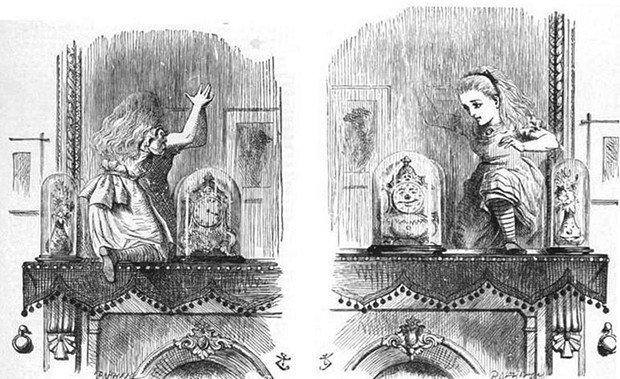
Illustration by John Tenniel, public domain
Unlike multiverses, Alice's looking-glass world is accessible from this one.
[
{
"name": "Top Stories Video Pair",
"insertPoint": "7",
"component": "17087298",
"parentWrapperClass": "fdn-ads-inline-content-block",
"requiredCountToDisplay": "1"
}
]
"... at a time when our world, the real world, faces serious problems, [scientists] dwelling on multiverses strikes me as escapism — akin to billionaires fantasizing about colonizing Mars."
John Horgan
There are two categories of multiverses, conveniently labeled "landscapes" and "dreamscapes" by physics professor Paul Halpern in his new book The Allure of the Multiverse. Landscapes "enlarge the universe along physical lines," that is, ideas, no matter how wild and counter-intuitive that can be entertained scientifically. Dreamscapes, on the other hand, "exist in a hypothetical domain of possibilities." For the latter, look no further than the Oscar-rich movie Everything Everywhere All at Once, in which the divine Michelle Yeoh, as a harried laundromat owner, connects with parallel universe versions of herself, saving us all in the process. There's also Amazon's Man in the High Castle series, the TV version of Philip K. Dick's novel about a dystopian America after Germany's victory in the Second World War. Rick and Morty fans will relate, too.
Here, I want to make the case that landscape multiverses are no more scientific than dreamscape multiverses, that is, they're figments of the fevered minds of physicists looking to explain weird observations with even weirder theories. The modern discussion of multiverses, i.e. other universes forever separate and unobservable from our own, began in the 1950s as an inventive response to the so-called "measurement problem" of quantum physics. This can be illustrated by Schrödinger's cat, a thought experiment: Whether an unfortunate cat, locked in a box, lives or dies depends on the random decay of a radioactive atom. Since this is a quantum event, it can go either way, and the only way to know is to open the box and check. Until the box is opened, the cat's fate is in a state of "superposition," neither alive nor dead.
This is called the Copenhagen Interpretation version of quantum mechanics, in which — weirdly — all outcomes are allowed until observation "collapses" several possibilities into a single one. And it has kept generations of physicists busy and tenured. (What counts as observation?) One of the wildest solutions to this apparent paradox came from then graduate Ph.D. student Hugh Everett in the 1950s, when he proposed that, actually, there is no collapse and instead, the universe splits in two when the box is opened! In one universe the cat is alive, in the other the cat is dead, each universe knowing nothing of the other. This splitting is happening at breathtaking speed, giving rise to umpteen unique universes every second. In one of these, you're appreciating the eloquence of this column; in another, you've decided the writer is nuts and you've got far better ways to spend your time.
And as if that version of the multiverse wasn't bad enough, there's "eternal inflation." Currently, the most popular version of how the universe came to be the way it now appears calls for an insanely short period of insanely large growth — inflation — during the second after the Big Bang. This radical idea from the 1980s solves a bunch of cosmological problems while also introducing another: Our universe is just one of a zillion so-called "bubble universes," with new ones being created every second ... forever.
Remember, these multiverses are merely mathematical constructs, artificial creations of physicists trying to explain what we observe in the knowledge that their ideas are forever untestable. If this is what science has come to, I'm going back to Dr. Strange. At least the Marvel multiverse can be appreciated by a mere mortal without a Ph.D. in astrophysics.
Barry Evans (he/him, [email protected]) wonders if his doppelgänger in another universe wonders if his doppelgänger in another universe wonders if ...
more from the author
-
Doubting Shakespeare, Part 1: Stratfordians vs. anti-Stratfordians
- Apr 25, 2024
-
A Brief History of Dildos
- Apr 11, 2024
-
Eclipse!
- Mar 28, 2024
- More »
Latest in Field Notes
Readers also liked…
-
Trouble on the Line: The Reality Part 2
- Nov 3, 2022
































